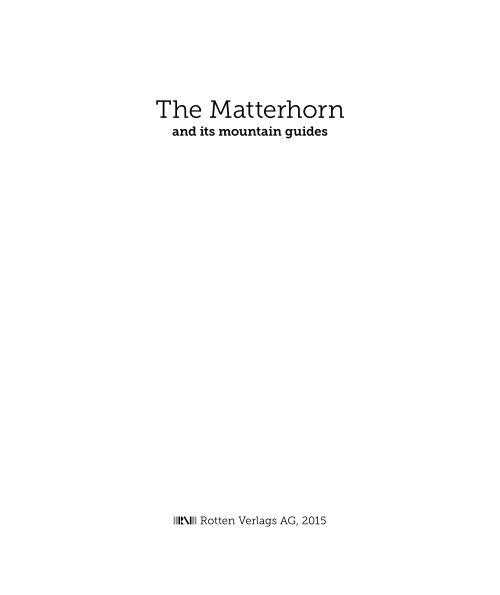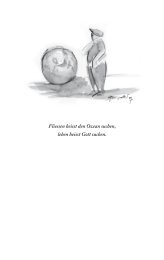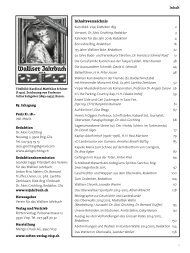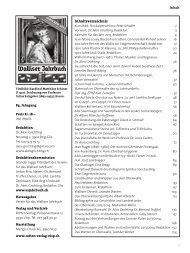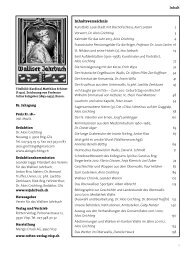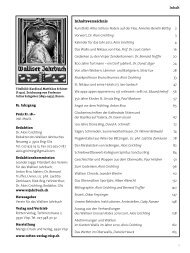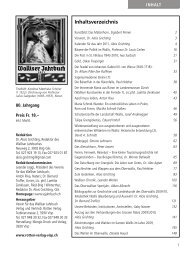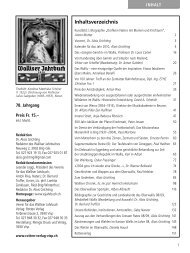Biner_Leseprobe
You also want an ePaper? Increase the reach of your titles
YUMPU automatically turns print PDFs into web optimized ePapers that Google loves.
The Matterhorn<br />
and its mountain guides<br />
Rotten Verlags AG, 2015
HERMANN BINER<br />
THE<br />
MATTER<br />
HORN<br />
AND ITS MOUNTAIN GUIDES
© 2015, Hermann <strong>Biner</strong>, Zermatt<br />
Published by the Mountain Guides’ Association Zermatt<br />
Author Hermann <strong>Biner</strong>, Zermatt<br />
Frontispiece by Ludwig Weh<br />
Layout by Sven Frachebourg, Rotten Verlags AG<br />
Translated by Dana Widmer, Zurich<br />
Publishing house Rotten Verlags AG, Visp<br />
Printed by Mengis Druck AG, Visp<br />
ISBN 978-3-906118-32-1<br />
Printed in Switzerland
Table of contents<br />
Preface 7<br />
The conquest of the Zermatt Mountains<br />
The first mountain guides 8<br />
Background on the first ascent of the Matterhorn 21<br />
Did the rope break? 36<br />
Interrogating Peter Taugwalder Senior 45<br />
The account of Peter Taugwalder Junior 51<br />
Jean Antoine Carrel 58<br />
The Silver Age 64<br />
Between two World Wars 75<br />
The end of the last millennium 83<br />
Matterhorn North Face and Furgggrat 96<br />
On faraway peaks 102<br />
The huts around Zermatt 110<br />
The Zermatt Mountain Guides’ Association<br />
The first association founded in 1858 114<br />
The new association 118<br />
The Matterhorn 123<br />
Mountain guide office and mountaineering school 127<br />
Social institutions 133<br />
Alpine events and incidents 136<br />
National and international mountain guides’ associations 139<br />
Rescue 142<br />
The mountain guide band 149<br />
Comrades who died in the mountains 152<br />
Historic table 156<br />
Annex<br />
Sources /picture credits 159<br />
Acknowledgements 163
Preface<br />
The Matterhorn – mystical, majestic, the mountain of all mountains. Its fascinating<br />
and captivating nature eludes no one; neither locals nor guests.<br />
The Matterhorn emits some kind of magical attraction, and a great many<br />
dream of standing on top of this mountain at least once in their lives.<br />
On July 14 of 1865, the Matterhorn was conquered for the first time. Four<br />
of the seven men lost their lives in the attempt. Zermatt and the tragedy at<br />
the Matterhorn resounded through the land; until this day, there is speculation<br />
on how this terrible accident occurred. The rope used to tie Edward<br />
Whymper, Taugwalder Senior and Taugwalder Junior to the rest of the<br />
roped party broke in the descent; the remainder of said rope can be found<br />
at the Matterhorn Museum, next to other relics of the first ascent.<br />
The first ascent of the Mont Blanc in 1786 initiated the Golden Age of Alpinism.<br />
This term is used to describe an era in which the highest and most<br />
challenging alpine mountains were conquered systematically. The alpinists<br />
of that time were usually scientists, lawyers or clergymen who took on the<br />
formidable icy giants with the help of local mountain guides.<br />
In the past years, several writings on early alpinism in Switzerland and other<br />
European countries were published. While reference was usually made<br />
to the mountain guides, virtually none of them are the protagonists in any<br />
of the publications. This book intends to bridge that gap by telling their<br />
story; it explains the importance of the mountain guides for the touristic<br />
development in the region.<br />
The information provided in this book is based on the research of numerous<br />
historical documents. The author successfully reconciles and documents the<br />
history of the mountain guides and the Zermatt Mountain Guides’ Association<br />
and created a piece that is of immeasurable value to them.<br />
Very special thanks go to our colleague and honorary member Hermann<br />
<strong>Biner</strong>. It was his deep bond with the mountains and the mountain guides<br />
that made this book possible in the first place.<br />
Benedikt Perren, President of the Zermatt Mountain Guides’ Association<br />
7
The conquest of<br />
the Zermatt Mountains<br />
The first mountain guides<br />
At the end of the 18 th century, the motivation to climb mountains was<br />
grounded in the quest for scientific knowledge and pure curiosity; with the<br />
exception of summits that had already been climbed in the early period for<br />
military reasons. Also, hunters reached the odd summit when following the<br />
trail of game. To the local population, however, the mountains rather posed<br />
a threat. In winter, they faced the danger of avalanches, and in summer,<br />
landslides and rock falls loomed. It was common belief that the summits<br />
were inhabited by spectres and demons. On the summit of the Matterhorn,<br />
there were believed to be remains of an ancient city. Moreover, the locals<br />
had plenty of work as peasants during summer; therefore, they had no<br />
reason to take on the extra effort of climbing a mountain.<br />
In Gressoney, a Valais legend circulated according to which a heavenly<br />
and pristine valley was located beyond the Lysjoch pass. This ‘lost valley’<br />
was most likely to be found in the Monte Rosa region, maybe in the Gorner<br />
Valley. It did not have anything to do with the Findeltriftje above Zermatt,<br />
where in recent years the term ‘lost valley’ has become quite popular.<br />
Historically speaking, it is to assume that the Gorner Valley was free of<br />
ice during the Medieval Warm Period (900 to 1,200 – the exact period is<br />
disputed) and consisted of a large lake surrounded by forests and fertile<br />
ground. Proof of this lies not only in Valais legends, but also in the findings<br />
of modern glaciology, for measurements have shown that the glacial<br />
soil beneath the Monte Rosa Hut is deeper than further out, close to the<br />
end of the terminus. If the ice were to melt today, we would again see the<br />
formation of a lake. Or, maybe, it was just wishful thinking by the Walser,<br />
hoping that there be a paradise somewhere out there where life would be<br />
8 The conquest of the Zermatt Mountains
Monte Rosa and Lyskamm<br />
with Gorner Glacier around<br />
1900. At the time, glaciers<br />
were significantly larger.<br />
easier. Such a legend actually exists on the Zermatt side. Here, as well,<br />
people dreamed of a paradise beyond the mountains.<br />
That is probably the reason why, in 1778, a group of Walser tried to reach<br />
the highest summit possible out of the Monte Rosa group. The goal of<br />
their expedition was to find that ‘lost valley’ beyond the Lysjoch pass. They<br />
started out in Gressoney and ascended to the Monte Rosa. It is not known<br />
how they moved across the glacier, which bore numerous rather dangerous<br />
crevasses. They reached the Entdeckungsfels (‘discovery rock’, 4,366m,<br />
at the foot of the Lyskamm), from which they were able to see the Zermatt<br />
side. When they realised that they had still more glaciers and mountains<br />
ahead of them, they gave up their endeavour.<br />
The conquest of the Zermatt Mountains<br />
9
Around the year 1780, strangers set foot in Zermatt for the first time.<br />
They were researchers, botanists, mineralogists and geologists. The locals<br />
gazed at them as if they had come from another planet. Stanislaus<br />
Kronig, past president of Zermatt, wrote the following, based on a report<br />
by a tourist: “The population was terrified when they saw the strangers<br />
arrive, armed with their knives and picks, carrying large cans as they<br />
had never seen before. Immediately, several groups formed and they exchanged<br />
theories, they whispered into each other’s ears, until the whole<br />
of Zermatt thought that these strangers were secret agents who wanted<br />
to spy on passes and crossings in order to take the sheep grazing in<br />
the Alps with them on their way back. Soon, the people gathered outside<br />
the clergy house, where the strangers were staying, and since they were<br />
thought to be spies, the mob demanded the pastor turn them over. To<br />
protect them from verbal slander and insults, the pastor accompanied<br />
them on their expeditions.”<br />
Old Zermatt church<br />
with Gorner Glacier in<br />
the background.<br />
10 The conquest of the Zermatt Mountains
On August 13 of 1792, natural scientist Horace-Bénédict de Saussure<br />
climbed the Klein Matterhorn (3,883m) for scientific purposes, together<br />
with mountain guide Joseph-Marie Couttet from Chamonix and 6 other<br />
guides. He measured the height of the Matterhorn with surprising accuracy:<br />
4,501m – exceeding today’s official measurement only by 23m.<br />
De Saussure explored the Alps in their entirety. He recorded barometric<br />
measurements, humidity and the intensity of the blue sky. In 1787, he undertook<br />
the first scientific ascent of the Mont Blanc, only one year after<br />
its first ascent. On the Italian side of the Monte Rosa, there were also<br />
scientists going about their investigations, among them topographer Joseph<br />
Zumstein and physician Friedrich Parrot.<br />
Back in those days, the clergy house was the only accommodation available<br />
in Zermatt. As of 1812, the pastor kept a visitors’ log. He recorded<br />
about 10 people a year. It was only after the Britons began exploring the<br />
Alps that the athletic aspect was added to alpinism, namely in the 1830s.<br />
Apparently, mountain guides started professionalising in Zermatt around<br />
1830, as well. In 1832, a certain Johann <strong>Biner</strong> called himself “the first<br />
botanical mountain guide of Zermatt”, whatever that meant. Peter Taugwalder<br />
Senior, who in 1865 (at the age of 45) belonged to the group of<br />
mountaineers who first ascended the Matterhorn, took up his profession in<br />
1840. By 1865, he had already climbed the Monte Rosa about 90 times.<br />
In 1838, ‘barber surgeon’ Joseph Lauber let three beds in his private<br />
house and quickly named the house Hotel Cervi. His hotel sign carried<br />
the inscription “Hotel Mont Cervi, bon loge à cheval et à pied” (French for<br />
‘good lodging for riders and pedestrians’). In 1852, Joseph Anton Clemenz<br />
of Visp, a member of the cantonal government, founded the first ‘real’<br />
Hotel in Zermatt, the precursor of the Hotel Mont Cervin. In its first year,<br />
the hotel registered 12 guest-nights. Lauber was not able to keep up with<br />
this kind of competition, so he sold his house to Alexander Seiler in 1854,<br />
who then changed its name to Hotel Monte Rosa. He refurbished and expanded<br />
the house, which then counted 28 beds. In 1867, Alexander Seiler<br />
also bought the Hotel Mont Cervin. In the early days of alpinism, the Seiler<br />
family contributed significantly to the boost in tourism in Zermatt.<br />
The conquest of the Zermatt Mountains<br />
11
In 1854, three Zermatt clergymen, under the aegis of pastor Ruden, opened<br />
the Hotel Riffelberg, which Alexander Seiler rented later on. This hotel served<br />
as point of departure for most tours between the Strahlhorn and the Matterhorn.<br />
Nowadays, this would be considered unthinkable, but back then the<br />
glaciers were significantly higher, and therefore the mountains were very<br />
accessible from that location.<br />
Before the Gandegghütte was inaugurated, the ascent to the Breithorn was<br />
undertaken via the old route, departing from the Riffelberg: One traversed to<br />
the Gorner Glacier, climbed said glacier to reach the Theodul glacier, from<br />
which one continued on to the foot of the ridge delimitating the northwest<br />
face of the Breithorn to the right (southwest).This ridge led to the Plateau<br />
Rosa, from which one ascended to the summit, as it is still done today.<br />
Nevertheless, without an additional bivouac many ascents starting at the<br />
Riffelberg were impossible to make.<br />
First ascents before 1850<br />
1801 Punta Giordani 4,046m by Pietro Giordani, together with<br />
local hunters<br />
1813 Breithorn 4,164m by Henry Maynard, together with<br />
Joseph-Marie Couttet, Jean Gras, Jean-Baptiste and<br />
Jean-Jacques Erin<br />
1819 Vincent Pyramide 4,215m by Johann Niklaus Vincent,<br />
together with miners and chamois hunters from Italy<br />
1820 Zumsteinspitze 4,563m by Johann Niklaus Vincent and<br />
Joseph Zumstein, together with companions from Italy<br />
1842 Signalkuppe 4,556m by Giovanni Gniffetti and other<br />
Italians<br />
1842 Riffelhorn 2,927m by John B. William and Valentine<br />
Smith, together with Zermatt mountain guides whose<br />
names are unknown<br />
1848 Grenzgipfel 4,631m by Johann Zumtaugwald and one<br />
guest<br />
12 The conquest of the Zermatt Mountains
Zermatt and the Matterhorn<br />
around 1900.<br />
Zermatt Bahnhofstrasse<br />
around 1900.<br />
Even back then, the<br />
guests of the noble<br />
hotel were escorted<br />
in a carriage.<br />
The conquest of the Zermatt Mountains<br />
13
Around 1850, tourist influx gradually increased and in the following years<br />
the Britons and their mountain guides (mostly native to Zermatt, Chamonix<br />
or the Bernese Oberland) climbed many of the great 4,000m peaks around<br />
Zermatt. In 1857, the British Alpine Club was founded – the very first alpine<br />
club in the entire world. To date, the Alpine Club gives relevant impetus to<br />
mountaineering worldwide. In Zermatt and other alpine centres, the British<br />
pioneers acted as a driving force, pushing to explore new heights and<br />
peaks. Almost all of them treated the mountain guides well, appreciated<br />
their skills and performance and compensated them accordingly.<br />
The Matterhorn represents the completion of all these first ascents. Just a<br />
few other peaks, which had been ‘overlooked’, were later added to the list,<br />
such as the Dürrenhorn. The following Zermatt guides at that time deserve<br />
special mentioning:<br />
The old Hotel Riffelberg.<br />
Up until the first huts<br />
were built, it served as<br />
point of departure for<br />
most tours between<br />
the Breithorn and the<br />
Strahlhorn.<br />
14 The conquest of the Zermatt Mountains
··<br />
Johann Zumtaugwald (first ascents of the Dom, Täschhorn, Rimpfischhorn,<br />
Grenzgipfel, Dufour Peak)<br />
··<br />
Johann Kronig (first ascent of the Dom, Dent Blanche, Allalinhorn via<br />
Feejoch)<br />
··<br />
Johann Kronig and Johann Zumtaugwald were involved in an accident<br />
in 1869 on the Lyskamm due to a snow cornice that broke loose. Their<br />
guest, Mr. Chester, died in the accident. The two guides were able to<br />
return to the Riffleberg, severely injured. After this incident, they did not<br />
participate in any further first ascents.<br />
··<br />
Peter Perren (born 1838, cobbler; in British literature, he was unfortunately<br />
mistaken for Johann Peter Perren, born 1834; first ascent of the<br />
Lyskamm E-Peak, Dent d’Hérens, Parrot Peak, Alphubel, Hohberghorn).<br />
Second ascent of the Aiguille Verte via the challenging Moine Ridge, just<br />
a few days after the first ascent of this peak by Whymper via ‘his’ couloir.<br />
Mont Blanc via Aiguille de Goûter. Attempt on the Matterhorn in January<br />
of 1862. In 1865, he planned the first ascent of the Matterhorn with his<br />
guest Thomas Stuart Kennedy. Kennedy, however, returned to England<br />
a few days before the ascent.<br />
··<br />
Joseph Marie Perren, brother of Peter Perren (first ascent of Pollux,<br />
Lyskamm E-Peak)<br />
··<br />
Franz <strong>Biner</strong> (first ascents of the Lyskamm W-Peak, Grandes Jorasses and<br />
Aiguille Verte together with Whymper, Hohberghorn. Also, Monte Cristallo<br />
and the Königsspitze. Attempted to climb the Matterhorn via the south<br />
face couloir). Later he specialised in climbing the Weisshorn and was<br />
dubbed ‘the Weisshorn <strong>Biner</strong>’.<br />
··<br />
Peter Taugwalder Senior (first ascents of the Matterhorn, Pollux, Allalinhorn<br />
via Feejoch, Obergabelhorn NNW-Ridge)<br />
··<br />
Peter Taugwalder Junior (first ascents of the Matterhorn, SE ridge of the<br />
Monte Rosa, Hohberghorn)<br />
Peter Taugwalder Senior and Peter Perren were the most experienced<br />
mountain guides in Zermatt at that time. Peter Taugwalder was the head<br />
of the mountain guides and Peter Perren was a ‘junger Wilder’ (young wild<br />
one). From among the foreign guides, mainly Melchior and Jakob Anderegg<br />
participated in several first ascents. Valaisman Johann Joseph Benet<br />
The conquest of the Zermatt Mountains<br />
15
deserves a special mention (the Britons called him Bennen): He guided<br />
the first ascent of the Weisshorn and reached the summit structure of the<br />
Matterhorn on the Italian side. The most active guests were Thomas Stuart<br />
Kennedy, Leslie Stephen, John Tyndall, Lord Francis Douglas, Charles<br />
Hudson and, of course, Edward Whymper.<br />
Mountain guide Franz<br />
<strong>Biner</strong> (‘Weisshorn <strong>Biner</strong>’).<br />
He accompanied Whymper<br />
on his first ascent of the<br />
Aiguille Verte and participated<br />
in first ascents in<br />
the entire Alpine region.<br />
16 The conquest of the Zermatt Mountains
Weisshorn from the north.<br />
Today still, the north ridge<br />
is one of the great classic<br />
tours in the Alps.<br />
Mischabel group: Allalinhorn,<br />
Rimpfischhorn, Strahlhorn.<br />
Easy 4,000m peaks that were<br />
first conquered around 1860.<br />
The conquest of the Zermatt Mountains<br />
17
First ascents between 1850 and 1865<br />
1848 Grenzgipfel 4,631m by Johann Zumtaugwald and<br />
Johann Madutz<br />
1854 Strahlhorn 4,190m by Franz-Josef Andenmatten and<br />
Ulrich Lauener, together with 2 Englishmen<br />
1855 Dufour Peak 4,634m by Matthäus and Johann<br />
Zumtaugwald and Ulrich Lauener, together with Charles<br />
Hudson and 4 other Englishmen<br />
1856 Allalinhorn 4,027m by Franz-Josef Andenmatten and<br />
Ferdinand Imseng<br />
1858 Dom 4,545m by Johann Kronig, Johann Zumtaugwald<br />
and Hieronymus Brantschen, together with an<br />
Englishman<br />
1858 Nadelhorn 4,327m by J. Zimmermann, Alois Supersaxo,<br />
B. Epiney and Franz Andenmatten, who had the task to<br />
install a triangulation point signal<br />
1859 Rimpfischhorn 4,199m by Johann Zumtaugwald and<br />
Melchior Anderegg, together with Leslie Stephen and<br />
another Englishman<br />
1860 Alphubel 4,206m by Peter Perren and Melchior Anderegg,<br />
together with L. Stephen and one other Englishman<br />
1860 Allalinhorn starting at the Feejoch by Johann Kronig,<br />
Peter Taugwalder Senior, Franz-Josef Andenmatten and<br />
Moritz Anthamatten, together with L. Stephen and 3<br />
other Englishmen<br />
1861 Weisshorn 4,505m by Johann Joseph Benet (Bennen)<br />
and Ulrich Wenger, together with John Tyndall<br />
1861 Castor 4,228m by Michel Croz, together with 2<br />
Englishmen<br />
1861 Lyskamm East Peak 4,527m by Peter and Joseph Marie<br />
Perren, J.P. Cachat, Franz Lochmatter, Karl Herr and<br />
Stefan Zumtaugwald, together with 8 Englishmen<br />
1861 Nordend 4,609m by Michel Payot, together with 3<br />
Englishmen<br />
18 The conquest of the Zermatt Mountains
First ascents between 1850 and 1865<br />
1862 Dent Blanche 4,356m by Jean-Baptiste Croz and Johann<br />
Kronig, together with Thomas Stuart Kennedy and<br />
William Wigram<br />
1862 Täschhorn 4,490m by Peter-Joseph Summermatter,<br />
Johann and Stephan Zumtaugwald, together with 2<br />
Englishmen<br />
1863 Dent d’Hérens 4,171m by Peter Perren, Melchior Anderegg<br />
and Jean-Pierre Cachat, together with 4 Englishmen<br />
1863 Parrot Peak 4,436m by Peter Perren and Melchior<br />
Anderegg, together with 3 Englishmen<br />
1864 Lyskamm W-Peak by Franz <strong>Biner</strong> and Jakob Anderegg,<br />
together with L. Stephen and one other Englishman<br />
1864 Pollux 4,092m by Peter Taugwalder Senior and Joseph<br />
Marie Perren, together with one guest<br />
1864 Zinalrothorn 4,221m by Melchior and Jakob Anderegg,<br />
together with L. Stephen and one other Englishman<br />
1864 Dent Blanche SW-Side by Christian Lauener and Franz<br />
Zurfluh, together with one guest<br />
1865 Obergabelhorn 4,063m (E-Side) by Jakob Anderegg,<br />
together with 2 Englishmen<br />
1865 Obergabelhorn 4,063m NNW-Ridge (a few days before<br />
the first ascent of the Matterhorn) by Peter Taugwalder<br />
and Joseph Vianin, together with Lord Francis Douglas<br />
1865 Matterhorn 4,478m by Peter Taugwalder Senior and<br />
Junior, Michel Croz, together with Charles Hudson, Lord<br />
Francis Douglas, Douglas Robert Hadow and Edward<br />
Whymper<br />
1865 Matterhorn 4,478m via the Italian Ridge by Jean<br />
Antoine Carrel and Jean-Baptiste Bich, who bypassed<br />
the last rock step via a traverse in the west face (Galerie<br />
Carrel) and completed the ascent via the Zmutt Ridge<br />
(Zmuttgrat)<br />
The conquest of the Zermatt Mountains<br />
19
Alphubel from the west. In<br />
1879, the face was climbed<br />
for the first time, namely<br />
by mountain guides Peter<br />
Taugwalder Junior and<br />
Abraham Imseng, together<br />
with one guest.<br />
The kings of the Mischabel<br />
group are the Dom and the<br />
Täschhorn. Both 4,000m<br />
peaks rank among the<br />
highest in the region,<br />
and their ascent is long.<br />
Traversing both peaks is a<br />
great classic tour.<br />
20 The conquest of the Zermatt Mountains
Background on the first ascent of the Matterhorn<br />
The innumerable pieces written on the first ascent of the Matterhorn are –<br />
with few exceptions – based on Edward Whymper’s account in Scrambles<br />
amongst the Alps and The first Ascent of the Matterhorn. These texts were<br />
the foundation for further books published in many different languages.<br />
They portray Whymper’s extraordinary achievements, but also describe<br />
what he thought of the valley dwellers and the skills and performance of<br />
the mountain guides, in particular. Whymper discusses the poverty, the<br />
lack in education and the primitive way of living of the ‘natives’. From<br />
where he was standing, one might be able to understand his perception,<br />
but these natives were human beings nonetheless. Human beings who<br />
had very hard and simple lives before tourism brought a certain degree of<br />
upswing. By way of example: in 1865, the last famine in Valais lay barely a<br />
decade in the past. In those years, almost one fourth of the Valais population<br />
was forced to emigrate to Argentina or Algeria due to dire straits. Visp<br />
and the outer Visp Valley suffered from the aftermath of the catastrophic<br />
earthquake of 1855.<br />
Edward Whymper: Probably<br />
the most successful<br />
alpinist of his time.<br />
The conquest of the Zermatt Mountains<br />
21
Nevertheless, Edward Whymper’s mountaineering skills and achievements<br />
were excellent. The trail of his first ascents leads from Dauphiné<br />
to Chamonix to Zermatt. He was beyond the shadow of a doubt one<br />
of the driving forces on the Matterhorn. His merits notwithstanding, all<br />
these achievements would not have been possible without the help of<br />
the mountain guides. Whymper undertook first ascents in the Ecuadorean<br />
Andes with Jean Antoine Carrel as his guide. He had a great interest for<br />
the scientific aspects of alpine regions, as can be seen by his numerous<br />
analyses of natural phenomena such as glacial movements, of rock layers<br />
on the Matterhorn, the effects of a glacial stream, the formation of<br />
moraines, etc.<br />
Whymper wrote three different versions of his account of the first ascent.<br />
The first version was put down on paper by Whymper just a few<br />
days after the tragedy and was addressed to Edmund von Fellenberg.<br />
It was meant to be published in the Journal de Genève, but that did not<br />
happen. An almost identical article appeared in The Times on August<br />
8 of 1865. The second version is part of Whymper’s book Scrambles<br />
amongst the Alps, published in 1871. The third version was released in<br />
August of 1895 in the Journal de Zermatt. Also, Whymper had added<br />
an entry to the visitors’ book at the Hotel Monte Rosa a few days after<br />
the accident. This record was later ripped out of the visitors’ book, an<br />
outrageous act. When Whymper returned to Zermatt in 1869, he was<br />
furious to find the entry missing and added a new one, stating that he<br />
had written down an account of the devastating tragedy; an account that<br />
had apparently disappeared.<br />
As opposed to Whymper’s reports, the statements made by Peter Taugwalder<br />
Senior and Junior were barely acknowledged. Taugwalder Senior<br />
was interrogated by a judge after the accident, and the transcript of said<br />
interrogation remained sealed for 55 years. No one ever found out why. In<br />
1905, Peter Taugwalder Junior described the events leading to the incident<br />
to Theophil Lehner, who recorded it on paper – a document that got lost.<br />
In 1918, Peter Taugwalder Junior was interrogated once more on behalf<br />
of Mr Montagnier. A copy of this account has been preserved in the report<br />
of Danger & Blakeney in the Alpine Journal of May of 1957. The original<br />
document is filed in the archive of the Alpine Club.<br />
22 The conquest of the Zermatt Mountains
Lyskamm – one of the<br />
most dangerous mountains<br />
due to its cornices.<br />
Peter Perren, among<br />
others, was part of the<br />
party achieving the first<br />
ascent in 1861.<br />
The conquest of the Zermatt Mountains<br />
23
Some authors took it upon themselves to find other sources. A thorough<br />
analysis was published in May of 1929 by the SAC (Swiss Alpine Club)<br />
in its monthly journal called Die Alpen. Further analyses and comments<br />
came from members of the Alpine Club: they were critical of Whymper’s<br />
one-sided account, which consistently cast a damning light on the Taugwalders.<br />
Especially Sir Arnold Lunn questioned the relationship between<br />
Whymper and Taugwalder Senior and Junior in several contributions, and<br />
he came to the conclusion that Whymper did not treat them in a fair way.<br />
For years, Charles Gos investigated all available sources, even from the<br />
French-speaking region. In 1948, he published his findings in a book<br />
called Le Cervin. In view of the 100 th anniversary of the first ascent of the<br />
Matterhorn in 1965, Ronald W. Clark had been tirelessly collecting all British<br />
sources still preserved. His insights were published in a book called<br />
The Day the Rope Broke. It was also translated into German and released<br />
under the title Als das Seil riss. In his book, he points out several discrepancies<br />
among the individual testimonies and discusses the question if and<br />
why the rope between Peter Taugwalder Senior and Lord Francis Douglas<br />
broke. In the beginning of the 19th century, Swiss Martin Jaggi did some<br />
research in Zermatt, including the questioning of contemporary witnesses<br />
of the first ascent. He left a comprehensive collection of documents to his<br />
son Christian Jaggi. He himself did not have the opportunity to publish<br />
them anymore. His son passed them on to Hannes Taugwalder, who published<br />
the results of this research on the occasion of the 125 th anniversary<br />
of the first ascent of the Matterhorn in a book entitled Der Wahrheit näher<br />
(‘closer to the truth’). In this piece, the story is told from the Taugwalders’<br />
perspective, and there are several passages that diverge strongly from<br />
the British sources.<br />
It is known that the versions of Taugwalder and Whymper differ regarding<br />
crucial points, especially when it comes to the descent and the time after<br />
the accident. Whymper’s version, however, spread worldwide due to his<br />
book and the many lectures he gave in many places. In contrast, Peter<br />
Taugwalder Senior did not have the possibility to defend himself against the<br />
unfair accusations and allegations made by many. Additionally, Whymper<br />
either did not repudiate these reproaches at all, or he repudiated them too<br />
late. However, it was no coincidence that it was Peter Taugwalder Senior<br />
who had participated in the first ascent. He was one of the very few Zermatt<br />
mountain guides who believed that the ascent of the Matterhorn was within<br />
the realm of possibility.<br />
24 The conquest of the Zermatt Mountains
Between 1850 and 1865, Zermatt mountain guides mostly took on first<br />
ascents in the Mischabel group and in the Monte Rosa region. Worthy of<br />
mention in this context are, for instance, Johann Zumtaugwald, who participated<br />
in most of these expeditions; and Johann Kronig, who guided<br />
the first ascent of the Dent Blanche. Both of them attempted to climb the<br />
Matterhorn from the Italian side, but lost interest due to the high difficulty.<br />
Franz <strong>Biner</strong>, who took part in the first ascent of the Grandes Jorasses and<br />
the Aiguille Verte, also attempted to climb the south face of the Matterhorn<br />
together with Whymper and mountain guides Christian Almer and Michel<br />
Croz. They hatched the plan on the Theodulpass when they saw a prominent<br />
couloir in the south face leading up to the Furgggrat. They decided to<br />
climb up through said couloir and reach the Furgggrat; then they planned<br />
on traversing the east face in order to find a way for the ascent to the<br />
summit. It does not come as a surprise that their plan was not successful;<br />
furthermore, they faced severe rock fall in the south face.<br />
Matterhorn south face.<br />
The couloir leading to the<br />
Furgggrat is very visible. It<br />
was planned to climb the<br />
Matterhorn via this couloir<br />
and the east face.<br />
The conquest of the Zermatt Mountains<br />
25
The mountain guides consistently and actively interested in the Matterhorn<br />
were Peter Taugwalder Senior and Peter Perren. They had under their belt<br />
several technically challenging ascents comparable to the Matterhorn’s level<br />
of difficulty. Also, in 1862, they adventurously attempted to climb the Matterhorn<br />
during winter season, together with Thomas Stuart Kennedy. They<br />
assumed that the snow in the east face would provide better stability for<br />
climbing. However, on their way up to the Schwarzsee, the group was surprised<br />
by an avalanche; they barely made it out alive. They then reached<br />
the Chapel at the Schwarzsee, where the pastor allowed them to stay for the<br />
night. They set out for their journey at 6 am, facing bitter cold and stormy<br />
wind. They made their way through the knee-deep snow, over the Hörnli<br />
and up the ridge leading to today’s Hörnli Hut. Then, they continued on, but<br />
they realised that the dispersed powder snow was anything but helpful in<br />
their attempt to climb the mountain. The cold and the wind were so harsh<br />
that they had to abandon their plan. They built a large stone man, 1.8m<br />
tall, and left their names behind on a piece of paper sealed in a bottle. It<br />
remains unclear as to which height they had reached. However, in the first<br />
ascent several years later, the stone man was still visible and his location is<br />
estimated to be at 3,460m; it is more or less the section today called ‘auf<br />
dem Grat’ (‘on the ridge’).<br />
Mountain guide Peter<br />
Perren. Today, a faceless<br />
man – back then, one of<br />
the best mountain guides<br />
in Zermatt.<br />
26 The conquest of the Zermatt Mountains
Lord Francis Douglas was guided up the Gabelhorn by Peter Taugwalder.<br />
Peter Perren and Peter Taugwalder were Thomas Stuart Kennedy’s mountain<br />
guides for the attempt on the Matterhorn. Kennedy was friends with<br />
Reverend Charles Hudson, who recruited Michel Croz as mountain guide<br />
whenever possible. These three roped parties of two could have been the<br />
first to climb the Matterhorn; the fact that they were not is due to several<br />
coincidences or twists of fate, since they definitely would have had the skills<br />
necessary to succeed. Hudson, Kennedy and young Douglas held excellent<br />
reputations as mountaineers, and Michel Croz, Peter Perren and Peter<br />
Taugwalder received impeccable references from their British guests (with<br />
the exception of Whymper’s feedback regarding the latter two). They were<br />
recruited by the same clients over and over again – and Peter Perren was<br />
also hired to work in regions outside of Zermatt.<br />
Lord Francis Douglas.<br />
A gentleman whose life<br />
tragically ended at the<br />
Matterhorn. His body<br />
was never found.<br />
On the other side, there was Edward Whymper. He frequently changed his<br />
mountain guides and did not think much of most of them. He preferably<br />
worked with Michel Croz or Jean Antoine Carrel.<br />
Consequently, there were three predominant groups on the Zermatt side<br />
trying to conquer the Matterhorn:<br />
··<br />
Thomas Stuart Kennedy with Peter Perren as his guide<br />
··<br />
Michel Auguste Croz with Reverend Charles Hudson<br />
··<br />
Peter Taugwalder Senior with Lord Francis Douglas<br />
The conquest of the Zermatt Mountains<br />
27
Edward Whymper did not have any friendly relationships with the other<br />
Englishmen. He only met Douglas because Douglas visited him in Valtournenche<br />
just before the first ascent. Hudson and Kennedy were irritated<br />
by the fact that Whymper had ‘taken’ the Aiguille Verte from them and had<br />
made the ascent without informing them beforehand; they had been in<br />
Chamonix at the same time with the same goal in mind.<br />
Kennedy met Whymper in June of 1865, when they both stayed at the<br />
Hotel Monte Rosa. He allegedly told him about his intentions to be the<br />
first to climb the Aiguille Verte together with Peter Perren. At that time,<br />
the Aiguille Verte, apart from the Matterhorn, was the most discussed<br />
mountain in the British Alpine Club. Said ascent was supposed to be<br />
made together with Hudson, who was already in Chamonix. Back in<br />
England, Kennedy and Hudson had already made their plans for the<br />
summer. Whymper then decided to pre-empt them. He travelled to Valtournenche,<br />
where he met up with Michel Croz. However, Croz was only<br />
available for a few days before he had to go to Chamonix in order to<br />
guide Mr Birkbeck. That is why Whymper additionally recruited Franz<br />
<strong>Biner</strong> and Christian Almer as mountain guides. Together with his three<br />
guides, he then rushed to Courmayeur and was, in passing, the first to<br />
climb the Grandes Jorasses. The group lodged in Chamonix, but apparently<br />
without contacting Kennedy or Hudson. In the meantime, Peter<br />
Perren, together with Kennedy, had already made a first attempt to climb<br />
the Aiguille Verte through the north face; however, they had to give up<br />
due to the high level of difficulty and bad weather conditions. One day<br />
later, Whymper, together with <strong>Biner</strong> and Almer, successfully climbed to<br />
the summit via ‘his’ couloir. In Chamonix, this success was celebrated<br />
with gun salutes. Kennedy had to hear from his hotelier about Whymper’s<br />
victory and was deeply disappointed with his behaviour. He did congratulate<br />
Whymper, as good Englishmen do, but he made it very clear that<br />
he found it extremely irritating that Whymper decided to go behind his<br />
back in order for him to get the first ascent.<br />
Meanwhile in Chamonix, Mr Birkbeck, Michel Croz’ guest, fell ill; Croz found<br />
himself unoccupied and was immediately recruited by Hudson. Without said<br />
illness, Croz would not have been at the Matterhorn and the whole story<br />
would probably have taken a different turn. In the days to follow, Hudson<br />
was the second to climb the Aiguille Verte together with Croz, Kennedy,<br />
Peter Perren, Michel Ducroz and G.C. Hodgkinson. They had taken the<br />
Moine Ridge to reach the mountaintop – a route that is still considered to<br />
be very challenging today. The ascent took 16 hours and demanded the<br />
climbing of difficult and brittle rock.<br />
28 The conquest of the Zermatt Mountains
Aiguille Verte. Together with the<br />
Matterhorn, this mountain was<br />
one of the great alpine challenges.<br />
In 1865, Whymper achieved<br />
the first ascent of both summits<br />
just within a few days.<br />
Thomas Stuart Kennedy.<br />
He could have been the<br />
first to climb the Matterhorn,<br />
together with Peter<br />
Perren – could have.<br />
The conquest of the Zermatt Mountains<br />
29
However, Whymper was not always the winner of these competitions.<br />
Peter Perren set foot on the summit of the Dent d’Hérens before Edward<br />
Whymper did. Only a few days before, Whymper, guided by Jean Antoine<br />
Carrel, had to stop and turn back. Thomas Stuart Kennedy beat Whymper<br />
to the Dent Blanche, with the participation of Johann Kronig. And when<br />
Whymper attempted to climb it shortly after, he turned around just before<br />
reaching the peak, because when he laid eyes on a stone man, he realised<br />
that someone had been there before him. He allegedly said that he<br />
was not interested in peaks that had already been conquered.<br />
Dent d’Hérens. Peter Perren<br />
participated in the first ascent<br />
as a mountain guide. Whymper<br />
and Jean Antoine Carrel were<br />
forced to throw in the towel a<br />
few days earlier.<br />
30 The conquest of the Zermatt Mountains
The Matterhorn from the Zermatt side – the parties<br />
involved and their ascents<br />
1855 Charles Hudson is the first to set foot on the peak of<br />
the Dufourspitze, guided by Johann Zumtaugwald and<br />
others.<br />
1860 Thomas Kennedy with Peter Taugwalder and F.F.<br />
Tucket with his guide Jean Teirraz attempt to climb<br />
the still unconquered Lyskamm (W-Peak), starting in<br />
Chamonix. Due to the bad weather, the expedition had<br />
to be terminated.<br />
1861 Peter Perren and other guides successfully climb the<br />
Lyskamm (E-Peak) for the first time, together with 8<br />
guests. Kennedy is not among them.<br />
1862 In January, Thomas Kennedy, under the guidance of<br />
Peter Taugwalder and Peter Perren, attempts to climb<br />
the Matterhorn east face. He thought the snow would<br />
make it easier to climb. Furthermore, Kennedy was<br />
convinced that the best way to climb the Matterhorn<br />
was from the Zermatt side.<br />
1862 Thomas Kennedy, guided by Peter Taugwalder, attempts<br />
to climb the Dent Blanche. They had to give up only just<br />
below the summit, probably at the foot of the last rock<br />
tower, which remains virtually unclimbable even today.<br />
1862 Thomas Kennedy, guided by Johann Kronig and<br />
Jean-Baptiste Croz, successfully completes the first<br />
ascent of the Dent Blanche. They largely bypassed<br />
the difficult last rock tower with the descent into the<br />
west flank. Peter Taugwalder and Peter Perren had<br />
been recruited by other guests and were therefore not<br />
available. Whymper arrives late.<br />
1863 Peter Perren and two other guides led 4 guests to the<br />
Dent d’Hérens. Just a few days earlier, Whymper had to<br />
terminate his attempt guided by Jean Antoine Carrel.<br />
The conquest of the Zermatt Mountains<br />
31
The Matterhorn from the Zermatt side – the parties<br />
involved and their ascents<br />
1865 On June 28, Hudson and Kennedy, guided by Peter<br />
Perren, attempt to climb the Aiguille Verte, but through<br />
the north face – an impossible venture at that time. They<br />
turned around due to bad weather.<br />
1865 As soon as Whymper hears that Kennedy is on his way to<br />
the Aiguille Verte, he recruits Franz <strong>Biner</strong> and Christian<br />
Almer to pre-empt Kennedy. In passing, this group is the<br />
first to climb the Grandes Jorasses on June 24, together<br />
with Michel Croz. On June 29, Whymper, together with<br />
<strong>Biner</strong> and Almer, successfully completes the first ascent<br />
of the Aiguille Verte via the Whymper Couloir. Thomas<br />
Kennedy and Charles Hudson were disgruntled by the<br />
fact that Whymper did not inform them about his plans.<br />
1865 On July 5, Kennedy and Hudson, together with Peter<br />
Perren and Michel Croz, successfully complete the<br />
second ascent of the Aiguille Verte via today’s Moine<br />
Route; they did not simply want to follow the Whymper<br />
Route. Until this day, this tour is considered a long and<br />
difficult one.<br />
1865 On July 7, mountain guides Peter Taugwalder Senior<br />
and Joseph Vianin are the first to climb the Obergabelhorn<br />
via the NNW-Ridge, with Lord Francis Douglas as<br />
their guest. Just the day before, the first ascent of this<br />
peak was completed via the E-Flank.<br />
32 The conquest of the Zermatt Mountains
After the second ascent of the Aiguille Verte, in Chamonix, Peter Perren,<br />
Thomas Kennedy, Michel Croz and Charles Hudson discussed a possible<br />
joint ascent of the Matterhorn. The well-rehearsed roped parties Perren/<br />
Kennedy and Hudson/Croz were, beyond the shadow of a doubt, among<br />
the best who could potentially take on the Matterhorn. They had just completed<br />
several tours comparable to the Matterhorn in terms of difficulty.<br />
Had they had fate on their side, they could definitely have been the ones<br />
to accomplish the first ascent of the Matterhorn, together with the roped<br />
party Taugwalder/Douglas; Lord Francis Douglas had decided to climb the<br />
Matterhorn after he reached the top of the Obergabelhorn and saw that<br />
the east ridge of the Matterhorn was not nearly as steep as it had seemed<br />
looking at it from Zermatt.<br />
However, that is not what happened: instead of travelling to Zermatt, Thomas<br />
Stuart Kennedy went back to England, for he was called back in a telegram.<br />
His leaving frustrated Peter Perren, since he was very passionate<br />
about the Matterhorn. In 1871, he was the first Zermatt guide to climb the<br />
Matterhorn after the tragic accident.<br />
In the meantime in Zermatt, Lord Francis Douglas was getting ready for<br />
the first ascent. He sent the Taugwalders to the Matterhorn to reconnoitre<br />
the routes. They reported that the ascent seemed feasible via the Hörnligrat;<br />
this prompted Alexander Seiler to motivate Lord Douglas to take on<br />
the ascent directly. Lord Douglas, however, decided to go to Breuil via the<br />
Theodulpass to meet Whymper there. Maybe he also wanted to take a look<br />
at the east face of the Matterhorn.<br />
In Breuil, Lord Douglas met up with Whymper and told him about his plan.<br />
According to Whymper’s account, he and Douglas agreed on a joint expedition<br />
to the summit of the Matterhorn. Together they returned to Zermatt<br />
and gave Peter Taugwalder the task to find an additional guide. In his<br />
opinion, Peter Perren would have been the best man for the job; however,<br />
he was recruited by another guest for the Monte Rosa during that time. He<br />
obviously did not know that he could be needed as an additional guide for<br />
the Matterhorn now that Whymper had joined the party. That is why Peter<br />
Taugwalder decided to take his son on board.<br />
Meanwhile, the group of Michel Auguste Croz, Charles Hudson and Douglas<br />
Robert Hadow arrived in Zermatt and lodged at the Hotel Monte Rosa,<br />
as well. It did not take long before they realised that there were two groups<br />
climbing the Matterhorn at the same time. After the previous events at the<br />
Aiguille Verte, one can only imagine that Hudson was not exactly keen on<br />
The conquest of the Zermatt Mountains<br />
33
Dent Blanche.<br />
Here, Kennedy beat<br />
Whymper, guided by<br />
Johann Kronig and<br />
Jean-Baptiste Croz.<br />
joining efforts with Whymper. For the sake of being sensible, however, the<br />
Englishmen agreed to cooperate. Having said that, Hadow’s participation<br />
was disputed due to his lack of experience; the guides said that the situation<br />
would call for an additional guide – one guide per guest. Eventually,<br />
Whymper and Hudson decided they were just as capable as guides and<br />
that they therefore did not need another mountain guide. First, they also<br />
opposed Peter Taugwalder Junior’s participation. He was recruited as carrier<br />
and only later on became a guide, during the ascent.<br />
Mountain guide<br />
Michel Auguste<br />
Croz. One of the<br />
best at the time.<br />
34 The conquest of the Zermatt Mountains
Peter Taugwalder described Whymper as a rather mediocre alpinist. However,<br />
he attested Charles Hudson good mountaineering skills that came<br />
close to the guides’ capabilities. After all, with his 36 years of age, Hudson<br />
was the most experienced of all guests. Lord Douglas and Hadow were<br />
teenagers and Whymper was only 25 years old.<br />
The success on the Matterhorn was in great part the merit of Michel Croz.<br />
He guided the roped parties through the most difficult part of the route,<br />
when they had to sidestep onto the almost vertical north face. Since the<br />
discussion about the tragedy at the Matterhorn overshadowed all media<br />
coverage, Croz’ extraordinary performance was often overlooked. Croz was<br />
one of the best mountain guides of his time. His career was short but admirable.<br />
He successfully completed numerous and challenging first ascents<br />
in the Dauphiné and in the Alpine region between Chamonix and Zermatt.<br />
He was willing to take on any risk and no climbing problem seemed to be<br />
too difficult for him. Later on, Whymper sent him his last words of goodbye:<br />
“Michel Croz of Le Tour in the Valley of Chamonix, one of the best mountain<br />
guides I have ever had the pleasure to meet. He died pitifully, due to foolishness,<br />
in the first ascent of the Matterhorn on July 14 of 1865. Goodbye,<br />
dear Michel. St. Niklaus, July 26 of 1906. Edward Whymper.”[paraphrased]<br />
The first<br />
ascensionists of<br />
the Matterhorn.<br />
Only three of<br />
them survived.<br />
The conquest of the Zermatt Mountains<br />
35
Did the rope break?<br />
This next part of the story is widely known. The seven mountaineers successfully<br />
reached the summit of the Matterhorn. The descent was taken<br />
on in the following order: Croz, Hadow, Hudson, Lord Douglas and Peter<br />
Taugwalder Senior. Whymper and Peter Taugwalder Junior were the last<br />
ones to attach themselves to the roped party, so in the end, they were one<br />
roped party of seven. Then the tragedy occurred: just below the summit,<br />
in the almost vertical north face, Hadow slipped, according to Whymper’s<br />
account. He dragged Hudson, Douglas and Croz down with him. The rope<br />
was under such tension that it broke off between Lord Douglas and Peter<br />
Taugwalder Senior. The first four mountaineers disappeared into the awful<br />
abyss of the north face and fell almost 1,000m to their deaths. Whymper<br />
and the Taugwalders were the remaining three survivors. This tragedy is<br />
still controversially discussed today, 150 years after the accident.<br />
In Whymper’s account, it seems as if he was the one leading the two<br />
mountain guides down, instead of the other way around. The Taugwalders<br />
described it as being quite the opposite. The fact that Whymper remained<br />
roped up between the two Taugwalders speaks in favour of the second<br />
version of the story. The leader of the roped party should definitely not be<br />
in the middle. Furthermore, Peter Taugwalder Senior’s quick reflexes saved<br />
Whymper’s life; he managed to fixate the lax part of the rope between him<br />
and Whymper behind a boulder before the pull of the falling companions<br />
got to them.<br />
Did Peter Taugwalder or one of the other survivors cut the rope? This claim<br />
was first made by an author who never in his life had anything to do with<br />
Zermatt or the Matterhorn: Alfred Meissner, an Austrian poet and writer who<br />
grew up in Bohemia. However, the same question had already been raised<br />
in Zermatt immediately after the accident. Nonetheless, several facts contradict<br />
this version.<br />
36 The conquest of the Zermatt Mountains
The fall at the<br />
Matterhorn. This<br />
is what might<br />
have happened.<br />
The conquest of the Zermatt Mountains<br />
37
First of all, it begs the question whether such a thin hemp rope with a diameter<br />
of 8mm (which does not even measure up to today’s single static<br />
ropes) would have been able to withstand the force of four falling bodies at<br />
all. It has to be mentioned that the British Alpine Club carried out several<br />
tests regarding the resistance of ropes, and their findings were terrifying for<br />
all involved. The test consisted of holding a weight of 76kg, which is then<br />
dropped by a bare 1.5m. The Alpine Club reported that of the woven ropes<br />
normally considered to be very strong, not one resisted the strain of the<br />
fall; and of the carefully manufactured, spun ropes, not many withstood the<br />
forces inflicted on them. The ropes gave in in such an unsettling way that<br />
some of their members were deeply terrified, since they had been using<br />
such ropes regularly and fully relied on their integrity. They bestowed completely<br />
unjustified trust upon these cords. The only rope resisting all tests<br />
was the one made of Manila hemp. The Alpine Club stated that from that<br />
moment onwards, this type of rope would be carrying a seal of quality. One<br />
has to bear in mind that the rope used to tie Peter Taugwalder Senior and<br />
Lord Douglas together was not made of Manila hemp, and it was thinner<br />
that the ropes tested by the British Alpine Club. Furthermore, it had to carry<br />
the weight of four bodies roped up at an interval of about 8m. Therefore,<br />
the distance of the fall was far greater than the 1.5m in the tests. Also, the<br />
rope was hanging over an edge – something that even today leads to the<br />
breaking of ropes under relatively low strain.<br />
Another point concerns the injuries Peter Taugwalder sustained on his<br />
hand and his torso. According to Peter Taugwalder Senior’s account,<br />
the rope between him and Whymper was not taut, which allowed him to<br />
wrap it around a boulder above him as he saw his comrades fall. With<br />
his other hand, he tried to hold on to the thin connecting rope. Because<br />
of that, the pull of the falling companions was entirely absorbed by his<br />
hand and his upper body, since he had wrapped a large part of the thin<br />
rope around himself, as good mountain guides do. The subsequent injuries<br />
to his hand and torso were severe and still visible months after<br />
the accident. Peter Taugwalder showed them to his colleagues. He was<br />
probably lucky that the rope broke immediately; otherwise, his injuries<br />
would have been much worse.<br />
The part where the rupture was located was quite far away from Peter<br />
Taugwalder. Whymper said in his questioning by the investigating judge<br />
that the rope had broken midway between Peter Taugwalder and Lord<br />
Douglas. Since this report was sealed until after Whymper’s death, this<br />
statement of his was never considered. In his third version of 1895, in<br />
which Whymper described the events, he mentioned the breaking of the<br />
38 The conquest of the Zermatt Mountains
The fall site on<br />
the Matterhorn.<br />
Falling at this<br />
point meant a<br />
vertical drop of<br />
1,000m down<br />
onto the Matterhorn<br />
glacier.<br />
The conquest of the Zermatt Mountains<br />
39
ope explicitly for the first time, and his estimate of the distance between<br />
Peter Taugwalder and the rupture was at 2.5m. In this version, he talked<br />
about the boulder which Peter Taugwalder said to have used to fixate the<br />
lax part of the rope. In Whymper’s account, Peter Taugwalder held on to<br />
the boulder with his bare hands.<br />
Peter Taugwalder was at the mercy of the pull of four falling bodies; how<br />
could he have taken out a pocket knife, opened the blade and cut the<br />
hemp rope at a distance of 2.5m, and all of that while under the strain of<br />
four bodies hanging from said rope? Those who consider this hypothesis<br />
to be likely are more than welcome to demonstrate it at the original site<br />
of the accident, namely the north face of the Matterhorn, and with the<br />
original equipment: with hobnailed mountain boots. Back then, they did<br />
not yet have Tricouni boots, which later were considered modern.<br />
Peter Taugwalder Senior declared in the accident report that the mountaineers<br />
could have been saved if their fall was stopped. When the judge<br />
asked him whether the accident could have been prevented, he said that<br />
if the rope had not broken, he and Croz would have been able to pull the<br />
others back up.<br />
Douglas Hadow’s shoe. It was<br />
extremely difficult to move<br />
across the steep and smooth<br />
north face with these shoes,<br />
without crampons. Today,<br />
no one would even remotely<br />
consider climbing this way.<br />
40 The conquest of the Zermatt Mountains
The Matterhorn Museum in Zermatt has a piece of the allegedly original<br />
rope used in the accident. Whether that is true has never been proven, but it<br />
is safe to assume it is. The remainder of the rope were examined to find out<br />
if the rope broke or if it was cut intentionally. An expert report, written several<br />
years ago, came to the conclusion that it broke. However, a more recent<br />
report states that the rope was cut. Both scenarios are possible, though<br />
it seems more likely that the piece kept at the museum was indeed cut.<br />
In any case, the rope involved in the accident was most certainly cut into<br />
pieces after the incident. It is not difficult to put oneself in the shoes of the<br />
survivors at the time. Below them were the most challenging part of the descent<br />
and the terrifying abyss of the north face. Their comrades had just fallen<br />
to their deaths. The survivors had no other choice but to take the same route<br />
down. Peter Taugwalder had still an auxiliary rope of about 60m with him<br />
and next to him was a solid boulder that had saved their lives. Every sensible<br />
alpinist would use said auxiliary rope to facilitate the descent.<br />
Accounts of other ascents starting in 1868 show that they actually did use<br />
the rope; for about 10 years, it was still visible at the site of the accident.<br />
It has been proven that at least part of it was used to assist the descent.<br />
So, the end of the rope involved in the accident presented with a rupture.<br />
Whymper himself reported in his third version of the first ascent that he<br />
made Peter Taugwalder give him the ruptured end of the rope. There are<br />
several people who were able to testify to that account. One week after<br />
the accident, the bodies of Croz, Hudson and Hadow were buried in Zermatt;<br />
an empty grave was dug for Lord Douglas. Croz was entombed on a<br />
Catholic cemetery, while the ceremony for the Englishmen took place on<br />
the cemetery next to the English Church. Apparently, only three Englishmen<br />
were present: Whymper, McCormick and Frederic A.Y. Browne. The<br />
latter later wrote that Whymper showed him the ruptured end of the rope.<br />
Many years after the accident, Whymper visited Bishop Dr George Forrest<br />
Browne, who later became president of the British Alpine Club. He wrote<br />
the following about their encounter: “The bag in which he [Whymper] kept<br />
the remainder of the rope was tightly sealed.” Well-known British alpinist<br />
Geoffrey Winthrop Young also expressed his doubts about whether the<br />
rope at the museum really was the part with the original rupture. In a letter<br />
to Charles Gos he quoted a friend of his, Mr Conway, who allegedly had<br />
proof that the piece of rope at the museum was merely a chunk that was<br />
cut out of the original rope. In another piece of writing, Whymper related that<br />
Peter Taugwalder suffered from an unjustified suspicion: “Peter Taugwalder<br />
was incapable of cutting the rope in the moment of the accident, and the<br />
remainder of rope in my possession are proof of that.”<br />
The conquest of the Zermatt Mountains<br />
41
These bits of evidence show that the analysis of the rope at the Matterhorn<br />
Museum cannot clarify the question whether the rope broke, since it cannot<br />
even be proven that it is the actual piece with the ruptured end. It was most<br />
likely in Whymper’s possession.<br />
For a long time, Whymper did not comment on the question whether the<br />
rope broke or not, which gave the suspicions even more impetus. He<br />
raised another question, however; one that also concluded in an accusation<br />
against Peter Taugwalder Senior, even though the survivors most<br />
definitely owed him their lives. The question was: why did Peter explicitly<br />
use the thin rope? The accusation herein is that Peter intentionally used<br />
the thin rope so the breaking of the rope would save him in case someone<br />
in front of him slipped and fell. Whymper never actually said this out loud,<br />
but he never repudiated it, either. This was a treacherous accusation, and<br />
Peter Taugwalder suffered from it all his life, for he had no way of defending<br />
himself. After the accident, he did explain to the investigating judge<br />
why he used the thin rope, but the report was sealed and Peter did not<br />
speak English. Furthermore, the use of ropes with that diameter was very<br />
common at that time. Whymper himself said that he had also used such a<br />
thin rope in other ascents.<br />
There are some uncertainties regarding the ropes available for the descent.<br />
For one, Whymper names three types of rope in his book: A solid Manila<br />
rope, about 60m long; another rope of about 45m, not made of Manila<br />
hemp but thicker than the first one; and the aforementioned thin rope, about<br />
70m long. When describing the traverse to Zermatt, however, Whymper<br />
talks about 4 ropes, which were temporarily stored at the Schwarzsee. It<br />
goes to mention that the Manila rope supposedly consisted of two pieces<br />
of 30m each. In any case, it is safe to assume that this is the situation<br />
they were in at the time of the descent. When they were getting ready for<br />
the descent, Whymper and Hudson determined the order: Croz went first,<br />
followed by Hadow, Hudson and Douglas. Croz tied the 45m-long rope to<br />
his knapsack, in case he needed it as an auxiliary rope in the descent.<br />
Then, Croz roped up the first four comrades with a Manila rope, in intervals<br />
of 6-7m, according to Whymper’s later account. In any case, this specific<br />
rope was used and could not be applied anywhere else.<br />
While on the summit, Whymper decided to make a sketch. He ordered that<br />
young Peter stay with him and he kept the second Manila rope so both<br />
of them could rope themselves up with it. This left Peter Senior with the<br />
forth rope, which was the thin one. Additionally, he was not able to communicate<br />
with anyone else but his son. He only spoke the Zermatt dialect,<br />
42 The conquest of the Zermatt Mountains
The faulty rope at the<br />
Matterhorn Museum.<br />
Is it the original rope?<br />
Was it cut?<br />
no French or English. Young Peter had completed his military service in<br />
the French-speaking part of Switzerland, therefore he at least spoke some<br />
French and he knew a few words of English. Peter Taugwalder Senior<br />
then took the remaining thin rope, rolled most of it up around his shoulder<br />
and with the rest of it he tied himself to his guest Lord Douglas. As he<br />
described in the interrogation, he was convinced that said thin rope was<br />
strong enough to hold Douglas in case he slipped.<br />
The conquest of the Zermatt Mountains<br />
43
It also remains unclear whether Whymper himself cut one of the ropes<br />
during the ascent; as they were climbing up, he unhitched himself and<br />
overtook Croz so he could be the first one to reach the top. Sir Arnold<br />
Lunn, however, wrote that Whymper had actually cut the rope in order to<br />
overtake Croz. At least that is what Whymper supposedly told A.E.W. Mason,<br />
a member of the Alpine Club. Leslie Stephen as well as Sir Arnold<br />
Lunn had always defended the Taugwalders against Whymper’s silent<br />
accusations (silent because he never really spoke up about them).<br />
44 The conquest of the Zermatt Mountains
Interrogating Peter Taugwalder Senior<br />
In both interrogations conducted by judge Josef Anton Clemenz on July<br />
21 and 23 of 1865 in the Hotel Mont Cervin, Peter Taugwalder described<br />
the events leading up to the accident on the first ascent. These records<br />
were kept under seal for 55 years. It was only in 1920 that the authorities<br />
released the report after the Swiss Alpine Club Geneva had requested it<br />
following the advice of Jean-Ch. Courten, district judge of Sion.<br />
The questions regarding the planning and execution of the ascent are of<br />
special interest in this interrogation. Said questions are listed here below;<br />
the figures indicate the numbers of the questions in the original transcript.<br />
Excerpt from the first interrogation:<br />
23. Were you informed about the people participating in the ascent<br />
beforehand, and did you speak up regarding who should<br />
or should not take part? Also, did you mention the discrepancy<br />
between the number of tourists and the number of guides?<br />
They informed me on the number of participants, and I did not object.<br />
However, I did mention that, considering the number of tourists, there<br />
were not enough guides on the team. Whymper and Hudson replied<br />
that they were just as capable as the guides; I did not further comment<br />
on the issue.<br />
24. Who roped up the participants before the descent?<br />
The first four, namely lead guide Croz, Hadow, Hudson and Lord<br />
Douglas, were roped up by Croz. I tied myself to Lord Douglas with<br />
a special rope.<br />
25. Who was the first to be roped up?<br />
I do not remember exactly who was roped up first to Croz’ rope.<br />
26. Of what quality was said rope?<br />
It was a new, solid rope.<br />
The conquest of the Zermatt Mountains<br />
45
27. Who roped you up to Lord Douglas?<br />
I did it myself.<br />
28. Why was another rope chosen to tie you to Lord Douglas?<br />
Because the other rope was not long enough to rope me up to it, too.<br />
29. In your opinion, was the rope used between you and Lord<br />
Douglas strong enough?<br />
Had I considered the rope to be insufficiently strong, I would never have<br />
used it to tie myself to Lord Douglas, since I would not want to put him<br />
or myself at risk by doing so. If I had thought the rope was too weak,<br />
I would have realised that before the ascent of the Matterhorn and I<br />
would have rejected it.<br />
Mountain guide<br />
Peter Taugwalder<br />
Senior. He may<br />
have survived, but<br />
the tragic outcome<br />
of the first ascent<br />
destroyed his life.<br />
46 The conquest of the Zermatt Mountains
30. Please, tell us more about the site of the accident.<br />
After we had descended about 200m to 300m from the summit, we<br />
reached the second of the difficult passages; there, the rock was completely<br />
smooth and it was very challenging to gain a foothold. It then so<br />
happened to be the spot where Hadow slipped and dragged down the<br />
others, which in turn pulled down Croz, but only after the rope between<br />
Lord Douglas and myself had broken.<br />
31. Do you believe that all necessary safety measures were taken?<br />
I do. However, it is deplorable that Hadow was such a poor mountaineer.<br />
32. How did the accident occur?<br />
I just told you. But I would like to add that Mr Whymper, my son and<br />
I wanted to leave the site of the accident immediately; nevertheless,<br />
we stayed there for a while longer. Eventually, we descended to<br />
find a place to camp for the night. The next day, we arrived safely<br />
in Zermatt.<br />
33. Was the rope taut in the moment of the accident?<br />
It was taut.<br />
34. What do you think of the rope breaking?<br />
I do not know. But the weight of three people and the force of the fall<br />
would even have caused a strong rope to break.<br />
Would you like to add or amend anything?<br />
I would like to add that, in order to gain better traction, I turned towards<br />
the mountain. Since the rope between Whymper and me was lax, I was<br />
fortunate enough to be able to wrap it around a boulder, which gave<br />
me the strength necessary to save myself.<br />
35. Would it have been possible to hold on to the four men after<br />
the rope broke?<br />
Impossible.<br />
The conquest of the Zermatt Mountains<br />
47
36. Could you have saved the tourists had the rope not broken?<br />
I am convinced that I could have saved the tourists with Croz’ help.<br />
Excerpt from the second interrogation:<br />
53. Did anything you remember change since the last interrogation?<br />
Would you like to add or amend anything?<br />
No, nothing. Except that, before reaching the dangerous passage, I told<br />
lead guide Croz to use an additional rope for better safety. Croz replied<br />
that it was not necessary.<br />
54. Did your son know how the accident occurred?<br />
I doubt it, since he asked: “Are you still there, father?”<br />
55. How come there were three men between Croz and you, but<br />
only one man between you and your son? The investigating<br />
judge thinks that this distribution was unreasonable. What do<br />
you have to say to that?<br />
Lead guide Croz went first, followed by Hadow, then Hudson, who<br />
considered himself to be a guide. He was followed by Douglas, me,<br />
Whymper and then my son. If the investigating judge acknowledges<br />
Hudson’s capability as a guide, you can see that each tourist was roped<br />
up between two guides.<br />
56. Did the roped party acknowledge Hudson as a guide?<br />
He said himself that he did not need a guide and that he could take on<br />
the responsibility of a guide.<br />
57. Who provided the rope used to tie you to Lord Douglas?<br />
The gentlemen tourists.<br />
48 The conquest of the Zermatt Mountains
58. Was your son recruited as a guide or a carrier?<br />
On the first day as a carrier, on the second day as a guide. In the beginning,<br />
the gentlemen wanted to send my son back; they argued that<br />
Croz and I would be enough in terms of guides necessary. I then urged<br />
them to take my son as a guide, which they did.<br />
59. At what time did you leave Zermatt on July 13?<br />
Sometime between 5 and 6 o’clock in the morning.<br />
60. At what time did you arrive at the campsite where you spent<br />
the night?<br />
Around noon.<br />
61. When did you leave the campsite on July 14?<br />
Around 2 o’clock at night. We then had a delay of about half an hour.<br />
The gentlemen were in good spirits and had even uttered cries of joy.<br />
62. (Astonishingly, this question and its answer are missing from the<br />
transcript.)<br />
63. Mr Whymper said in his statement that Hadow was the first to<br />
slip, which dragged Croz down, and both of them then pulled<br />
down Hudson and Douglas. He further stated that he and the<br />
Taugwalders were able to gain a solid foothold in the meantime.<br />
That was the moment when the rope broke, according to<br />
Whymper. In your answer to question 30, however, you state<br />
that Hadow slipped first, then Hudson and Douglas, and then<br />
Croz, only after the rope had broken. Due to the discrepancy<br />
between Whymper’s statement and yours, you are herewith<br />
asked to tell us whether you want to adhere to your original<br />
statement.<br />
Since Mr Whymper was located above me, he probably had a better<br />
view of the situation and might be able to give a more detailed account<br />
on what happened. Therefore I do not want to set in stone that Croz<br />
only fell after the first three had slipped. Everything occurred within the<br />
blink of an eye; we were too surprised as to be able to give an exact<br />
account of the incident.<br />
The conquest of the Zermatt Mountains<br />
49
64. Would you like to add or amend anything in your statement?<br />
I would like to add that, in order to gain better traction, I turned towards<br />
the mountain. Since the rope between Whymper and me was lax, I was<br />
fortunate enough to be able to wrap it around a boulder, which gave me<br />
the strength necessary to save myself. Because the others fell, the rope<br />
tying me to them was under such great strain that I sustained severe<br />
injuries to the parts of my body where the rope was wrapped around<br />
it; I am still in pain today.<br />
For months, Taugwalder Senior suffered from the injuries caused by the<br />
rope in the accident. The rumour that he had intentionally cut the rope destroyed<br />
his life. The people of Zermatt always considered him to be innocent;<br />
in the Alpine society, however, the suspicions lingered. He had no way<br />
of defending himself against these wrongful accusations, so he simply swallowed<br />
this injustice. For years, Whymper travelled the world as “conqueror<br />
of the Matterhorn” and gave lectures. Taugwalder Senior, on the other hand,<br />
withered away under the weight of the treacherous allegations. In 1874, he<br />
emigrated to the United States of America and returned to Switzerland in<br />
1878. No one knows what he had seen and done on the other side of the<br />
Atlantic. In 1888, he was found in the chapel of Maria zum Schnee (‘Mary<br />
of the Snow’), where he had died at the foot of ‘his’ mountain.<br />
The Chapel Maria<br />
zum Schnee. In 1888,<br />
Peter Taugwalder<br />
Senior was found<br />
dead at the foot of<br />
‘his’ mountain.<br />
50 The conquest of the Zermatt Mountains
The account of Peter Taugwalder Junior<br />
As early as 1905, Theophil Lehner, schoolteacher and postmaster in Zermatt,<br />
had conducted an interview with Peter Taugwalder Junior. There are<br />
no records left of this conversation. In 1918, the questioning was repeated<br />
on behalf of Mr Montagnier. Peter Taugwalder Junior’s account – he was<br />
75 years old at the time – is reproduced here:<br />
Mountain guide Peter<br />
Taugwalder Junior. He<br />
climbed the Matterhorn<br />
about 120 times.<br />
The conquest of the Zermatt Mountains<br />
51
Peter Taugwalder:<br />
Mr Montagnier, dear Sir<br />
You asked me to give an account of the first ascent of the Matterhorn in<br />
1865, the reason for the tragic accident, in which four strong and distinguished<br />
men lost their lives. I am now 75 years of age, but despite the 53<br />
years that have passed since, I remember many things so vividly, as if it<br />
had happened only yesterday. The impression this terrible tragedy left is<br />
so strong that I will never forget it for as long as I live.<br />
It was the first half of July in said year, when young Lord Douglas came<br />
to Zermatt to undertake several climbing expeditions guided by my late<br />
father; the first ascent of the Obergabelhorn, amongst others. He had the<br />
intention to be the first to climb the Matterhorn, as well. It was then, on<br />
July 10 or 11, when Chamonix mountain guide Michel Croz arrived at the<br />
Hotel Monte Rosa, accompanied by the Englishmen Whymper, Hadow and<br />
Hodson, who had the very same intention to complete the first ascent of<br />
the Matterhorn. After hearing their plans, Lord Douglas and his mountain<br />
guide decided to join the group.<br />
At that time, I was indeed still very young; I had merely started growing<br />
the first facial hair on my upper lip. However, I was courageous enough<br />
to feel that no rock wall was too high, no glacier too steep. At only 16, I<br />
had already climbed the Monte Rosa, together with three British students<br />
and my father. He did not want me to go with them, because he feared<br />
that it would be too cold for me. I must tell you, the Monte Rosa was a<br />
notoriously cold mountain; many have lost their toes climbing it. Nevertheless,<br />
I insisted I go with them, since I was the one who convinced the<br />
students to attempt the ascent. That is why they were just as much my<br />
clients as they were my father’s. And I told him that if he did not want to<br />
lead said ascent, I would find another mountain guide who would. Long<br />
story short: I went with them and it was a great success; my joy alone<br />
would have carried me to the summit.<br />
52 The conquest of the Zermatt Mountains
Obergabelhorn south face. Only<br />
in 1923, mountain guides Adolf<br />
and Alfred Aufdenblatten and<br />
their guest succeeded in climbing<br />
this face on a direct route.<br />
Mountain guides Peter Taugwalder<br />
Senior and Joseph Vianin,<br />
with Lord Francis as their guest,<br />
were the second party to climb<br />
this mountain in 1865. Their route<br />
led them through the north side.<br />
But to come back to the main subject: when it came to mountaineering, I<br />
was not an amateur anymore. At the time, I had already under my belt the<br />
ascent of the Breithorn and several others, which is why I suggested to my<br />
father to let me accompany them. Originally, he had planned on hiring two<br />
additional mountain guides, creating two roped parties, but his idea did not<br />
please Mr Hudson; he, the humble man he was, believed that he and his<br />
companions were more skilled than the mountain guides.<br />
In the morning of July 13, we fetched the necessary provisions from the<br />
Hotel Monte Rosa and started our journey at around 9 o’clock. The weather<br />
was wonderful; the Matterhorn, completely free of snow, was warmly<br />
welcoming us in the morning sun. We had lunch on the Hörnli. The view<br />
was magnificent; we were surrounded by great, majestic summits. Above<br />
the green of the valley, the dark scots pines thronged to the edge of the<br />
eternal ice. My heart was pounding out of joy, and I could barely await<br />
the next morning. When we reached the foot of the Matterhorn, we set<br />
up our tents and camped. However, Croz and I climbed quite a bit higher<br />
to approximately the same spot where they later built the so-called Altes<br />
Refugium (‘Old Refuge’). Everything went without a glitch and we did not<br />
have the slightest difficulties. We returned to our companions and told<br />
them the good news. We enjoyed the soup the others had prepared in the<br />
meantime and eventually laid our heads on our knapsacks to get some<br />
rest. I slept like an angel.<br />
The conquest of the Zermatt Mountains<br />
53
All night, I dreamt about standing on top of the Matterhorn, sending a<br />
yodel down into the valley, loud enough to be heard in all of Zermatt. And<br />
then, suddenly, I was all alone on the summit. I was not able to see the<br />
others, and the terror of that woke me up. It was about 2 o’clock and the<br />
others had started to wake up, as well. We made some tea after which<br />
we started our attack of the enormous peak before us. Of course, we<br />
roped up immediately; Croz led the party, followed by Hudson, Whymper<br />
and Hadow, then my father, Lord Douglas and I. At about three o’clock,<br />
the day began to dawn and the sky in the east was shimmering like pure<br />
gold. There was not a single cloud in sight; the only audible sounds were<br />
the steps of seven passionate mountaineers and the clattering of the ice<br />
picks on the rock.<br />
We followed the same route Croz and I had reconnoitred the night before.<br />
Everything went smoothly until we reached the bit above the place<br />
where the Old Refuge is located today. From that point onward, the level<br />
of difficulty started increasing, but we were all of good cheer and able to<br />
quickly gain height. About 150 feet above where today’s Solvay Refuge<br />
is located, we rested and had a little something to eat in order to restore<br />
our strength. Then, we attacked the shoulder, into which Croz carved<br />
steps. Douglas, who was in front of me, had great difficulty placing his<br />
feet on the steps, and several times he slipped. But for most of the time,<br />
I pressed his feet firmly into the steps. Finally, we reached the shoulder.<br />
We left our knapsacks and provisions at the very top; nowadays, that is<br />
where the fixed ropes begin. We deliberated on the route we should take<br />
to overcome the most challenging part of the climb. We knew that it would<br />
get easier once we were above the roof. Croz was the one who took the<br />
decision to cross over to the west face, the so-called ‘in d’Lätzi’ (‘shady<br />
slope’). It was entirely free of snow, and there were small, naturally formed<br />
steps about one or two inches wide; we used them to climb our way up.<br />
Below us was a 6,000-feet vertical drop, as steep as it gets. Not a word<br />
was uttered while we were cautiously and tensely climbing up. We were<br />
all very well aware of the seriousness of the situation.<br />
Just one wrong movement or one wrong step and our bodies could have<br />
ended up down on the glacier, dashed to pieces. I was young and agile<br />
and I climbed the mountain like a cat climbs a tree. I was always able<br />
to observe the others and to secure Lord Douglas’ feet for him. He was<br />
not the best mountaineer. Slowly but surely, we safely made our way<br />
up; finally, we reached the bit above the roof. At around 2 o’clock, we<br />
reached the summit.<br />
54 The conquest of the Zermatt Mountains
The summit of the<br />
Matterhorn. Standing<br />
on top of it is<br />
an enormous rush.<br />
The conquest of the Zermatt Mountains<br />
55
We did not stay for long. My heart was so light, I felt like I could have flown<br />
far away, above and beyond the mountains, maybe even down to Zermatt to<br />
see my sweetheart. Then, we made ready for the descent. Whymper traded<br />
places with Lord Douglas and was now directly in front of me on the rope.<br />
Croz was still leading the group. So we slowly climbed down across the roof,<br />
at approximately the same section where the descent still crosses today.<br />
After that, we traversed back to the west face, along a ledge. We moved<br />
very slowly and with the utmost caution, since the descent was considerably<br />
more difficult than the ascent. We got to the end of the ledge, where Croz<br />
started to climb down the north face together with the three men closest to<br />
him. From time to time, my father belayed the rope on a ledge.<br />
All of a sudden, the four men shot through the air, almost as if they were<br />
leaving behind a small cloud where they used to stand. The rope broke as<br />
if it had been a mere thread; the four young mountaineers were gone. It<br />
happened as fast as lightning strikes. No one made a sound. They had disappeared<br />
into the dreadful abyss.<br />
One can only imagine how we felt. We were barely able to move – that is<br />
how shocked we were. Eventually, we tried to continue our descent; but<br />
Whymper was shaking so much, he was almost incapable of taking a step<br />
forward. My father took the lead and kept turning around in order to secure<br />
Whymper’s feet while climbing down the steps. We had to stop repeatedly<br />
to rest, for we were deeply shaken by what had happened. Nevertheless,<br />
we kept going and, eventually, we were back on the ridge, where we tried<br />
to eat something; it was virtually impossible, though. Our throats felt as if<br />
we were being chocked, incapable of swallowing anything. This was not<br />
surprising, since further down we saw our unfortunate comrades lying on<br />
the cold ice of the glacier. My heart was aching and tears ran down my<br />
cheeks. Our poor, poor friends. Only that same morning had they been<br />
alive and full of joy; now their broken, lifeless bodies were lying on the<br />
bitter-cold glacier.<br />
And if only the good Mr Douglas had not traded places, then he would<br />
have been the one who survived; he would well have been a better and<br />
more loyal friend to us than this Mr Whymper, who had been so very<br />
unapproachable and distant – and still was afterwards, even though we<br />
had saved his life. Without us, he would have died, as well. He later told<br />
a different story, a story in which he was the hero, and he said things<br />
that were not true. I, for instance, never saw any of the three crosses Mr<br />
Whymper had allegedly spotted in the sky. Furthermore, he put words into<br />
our mouths, without any motivation. How could he have understood any<br />
56 The conquest of the Zermatt Mountains
of the things we were saying? He did not speak a word of German, and<br />
my father spoke no other language besides a dialect native to Zermatt.<br />
But let’s get back to the descent. We fetched the knapsacks and then,<br />
with great difficulty, made our way to a snow-free spot below the ridge,<br />
where we spent the night, sitting down. Just before dawn, temperatures<br />
were very low, despite them having been quite moderate in general. As<br />
soon as we had enough daylight, we continued the descent. We did not<br />
encounter any further difficulties; once we were on the move, we regained<br />
our agility, although we only reached Zermatt around 3 o’clock.<br />
Upon arrival, we went to see Father Seiler at the Monte Rosa right away<br />
to tell him about the tragic incident. Measures were immediately taken to<br />
recover the remains of the deceased. It was a Saturday, and because they<br />
were all undoubtedly dead, there was no reason for anyone to set out for<br />
the mission at night. The rescue team waited for the day to dawn before<br />
leaving Zermatt. I was not able to accompany them; I was still very much<br />
in shock. Whymper and my father were not able to go, either.<br />
The search party found our poor friends on the glacier, at the very spot<br />
we had indicated. Only Lord Douglas was missing – and until this day,<br />
his body’s whereabouts remain unknown. They had all been dashed to<br />
pieces, Croz being the worst case of them all. They had lost most of their<br />
clothes. A few days later, the whole community attended their funeral at<br />
the cemetery of the tiny Zermatt church.<br />
I have climbed the Matterhorn over one hundred times ever since, but<br />
never without thinking of my dear comrades who lost their lives in a terrible<br />
accident that day. My father and Whymper have already joined them in<br />
heaven, and soon, the angels of death will call for me, as well.<br />
I have now told you in a simple and wholehearted way, what I had seen<br />
and experienced at the first ascent of the Matterhorn. If you choose to<br />
preserve my story for posterity, I put my good name in the hands of those<br />
who read it. I herewith close my report.<br />
Peter Taugwalder Junior’s mountain guide skills were in high demand and<br />
he climbed the Matterhorn another 120 times after completing the first ascent.<br />
At the age of 50, he had to abruptly end his mountaineering career<br />
after a rock fall at the Matterhorn had shattered his knee. He retreated to<br />
‘zum Biel’, a lonely place between Zermatt and Täsch, where he had built<br />
a house in 1874.<br />
The conquest of the Zermatt Mountains<br />
57


